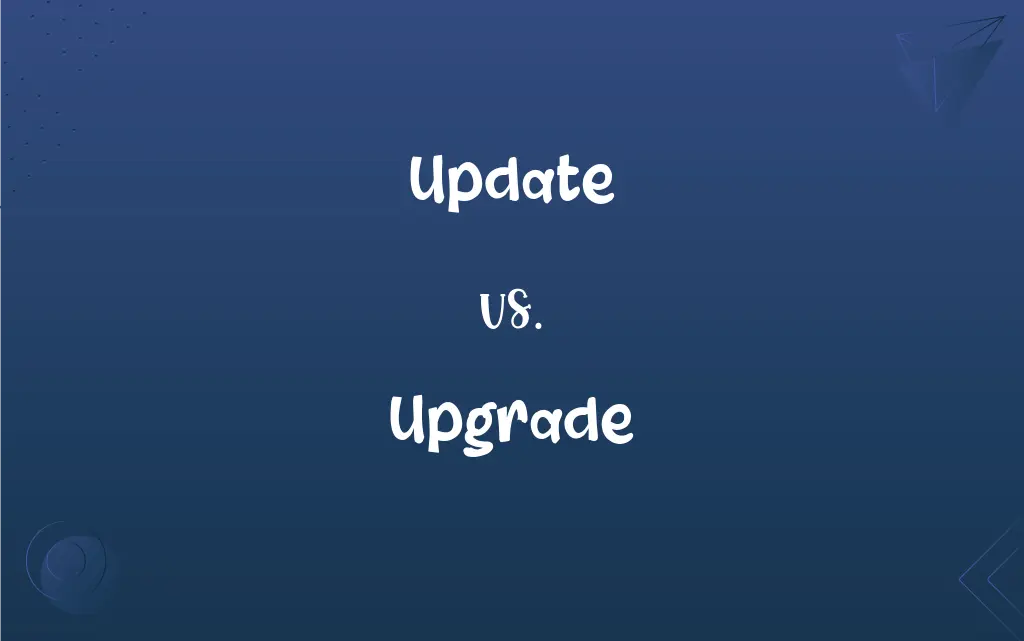Update vs. Upgrade: What's the Difference?
Edited by Janet White || By Harlon Moss || Updated on June 4, 2024
An update provides minor improvements or fixes to software, while an upgrade involves advancing it to a superior version, often with major changes or improvements.

Key Differences
Updates typically refer to minor changes, improvements, or fixes applied to software or systems. In a technological context, an update does not drastically alter the function or the user interface of the software; instead, it may fix bugs, enhance security, or provide minor improvements to existing features. Upgrades, conversely, generally involve a significant enhancement or improvement, whether in software, hardware, or other contexts. When a product is upgraded, it is elevated to a higher level of quality or features, often requiring a new purchase or a subscription change.
Updates and upgrades, while related in their purpose of improving a product or service, differ significantly in scope and impact. An update generally tweaks and refines the current version of a product or system, ensuring that it runs smoothly and securely without notably altering how it operates. It’s essential to periodically update software to protect against vulnerabilities and benefit from the latest minor improvements and fixes without significantly changing the user experience.
Upgrades, while also aimed at improvement, often bring about notable advancements, enhancements, or escalations in product quality, features, or performance. An upgrade is typically more discretionary than an update, providing users or consumers with an option to access additional features, improvements, or luxuries at an additional cost or investment. In technology, upgrading software or hardware can sometimes necessitate adjusting to new interfaces or functionalities, whereas in other industries, it may mean accessing a higher level of quality or service.
When considering updates and upgrades in various contexts, it is crucial to distinguish between the minor, often mandatory, and routine nature of updates and the substantial, optional, and often cost-associated nature of upgrades. Both serve to enhance and prolong the life or quality of a product or service but do so in fundamentally different ways and magnitudes.
Comparison Chart
Definition
A minor change or improvement
A significant enhancement or advancement
ADVERTISEMENT
Scope
Relatively minor or small improvements
Larger, involving new features
Cost
Typically free and automatic
Involves additional cost or a new purchase
User Experience
Rarely alters functionality or user experience notably
May change user interaction and experience
Frequency
Can be frequent and regular
Tends to be less frequent, with notable intervals
Update and Upgrade Definitions
Update
Updating can mean modifying an object to make it current.
I need to update my wardrobe for the upcoming winter.
ADVERTISEMENT
Upgrade
To upgrade can mean increasing the power or capacity of something.
I want to upgrade my computer’s RAM for better performance.
Update
To update can also mean refreshing existing information.
Please update your contact details on the website.
Upgrade
An upgrade involves replacing something old or outdated with something better.
The city plans to upgrade the old infrastructure.
Update
An update means introducing minor changes to improve or fix.
The company will send an update to fix the software bug.
Upgrade
Upgrading means enhancing the features or functionalities of a product.
The software upgrade introduced several new features.
Update
An update refers to providing the latest data or facts.
The weather channel will provide an update on the storm shortly.
Upgrade
An upgrade refers to raising something to a higher standard or quality.
They decided to upgrade their travel tickets to first-class.
Update
An update can imply bringing something in line with modern needs or styles.
It's time to update our traditional methods of working.
Upgrade
Upgrading implies elevating to a higher level or grade.
The army officer received an upgrade to a higher rank.
Update
To alter so as to be up to date
Update a textbook.
Update the files.
Upgrade
To raise to a higher grade or standard
Upgrading their military defenses.
Upgrade
To replace (a software program) with a more recently released, enhanced version.
FAQs
Does upgrading always involve an additional cost?
Often, upgrading involves an additional cost for accessing advanced features or superior models, but not always.
What does it mean to update software?
Updating software involves applying minor fixes or improvements without significantly altering its functions.
What does upgrading a device entail?
Upgrading a device generally involves replacing it with a superior model or enhancing its capabilities significantly.
Can an update affect system settings?
Typically, updates should not alter system settings, preserving user preferences and configurations.
How often should software be updated?
Software should be updated as often as updates are available to maintain security and functionality.
Can I skip updates and apply them all at once later?
While possible, it’s recommended to apply updates as they come for ongoing security and performance.
Can updates improve system speed or performance?
Some updates aim to enhance performance and might improve system speed, though significant boosts may require an upgrade.
Will upgrading erase my personal data or settings?
While upgrading should preserve data, it’s vital to back up personal information to avoid potential data loss.
Do upgrades ensure compatibility with newer technologies?
Upgrades often enhance compatibility with newer technologies, but it's wise to check specifics with the product provider.
What’s the difference between a system update and a software update?
System updates relate to the operating system, while software updates pertain to specific applications.
Is it necessary to upgrade if the current version works well?
While not always necessary, upgrading may provide benefits in features, security, and future compatibility.
What is the typical frequency of product upgrades?
The frequency of product upgrades varies by industry and product, with tech often experiencing more frequent upgrades.
Can I revert an update if it causes issues?
Depending on the software, reverting an update may be possible through backup points or uninstalling recent changes.
How significant are the changes in a typical upgrade?
Upgrades often introduce notable changes, such as enhanced functionalities, improved performance, or new features.
Can upgrades affect compatibility with other devices or software?
Yes, upgrades can sometimes alter compatibility and may require auxiliary software or devices to be upgraded too.
What are the risks of not upgrading to a newer version?
Risks of not upgrading can include missing out on improved features, functionalities, or security enhancements.
Why might an update be mandatory?
Updates might be mandatory to patch security vulnerabilities or fix issues affecting performance and usability.
Is it possible to update hardware components?
While firmware updates are common, physical updates to hardware are typically achieved by replacing or adding components.
How do I perform an upgrade on my device or software?
Upgrades can often be performed via device settings, user accounts, or through purchasing and installing new versions.
How do I know if a product is eligible for an upgrade?
Product eligibility for upgrades can often be determined through customer service, user accounts, or product documentation.
About Author
Written by
Harlon MossHarlon is a seasoned quality moderator and accomplished content writer for Difference Wiki. An alumnus of the prestigious University of California, he earned his degree in Computer Science. Leveraging his academic background, Harlon brings a meticulous and informed perspective to his work, ensuring content accuracy and excellence.
Edited by
Janet WhiteJanet White has been an esteemed writer and blogger for Difference Wiki. Holding a Master's degree in Science and Medical Journalism from the prestigious Boston University, she has consistently demonstrated her expertise and passion for her field. When she's not immersed in her work, Janet relishes her time exercising, delving into a good book, and cherishing moments with friends and family.
































































